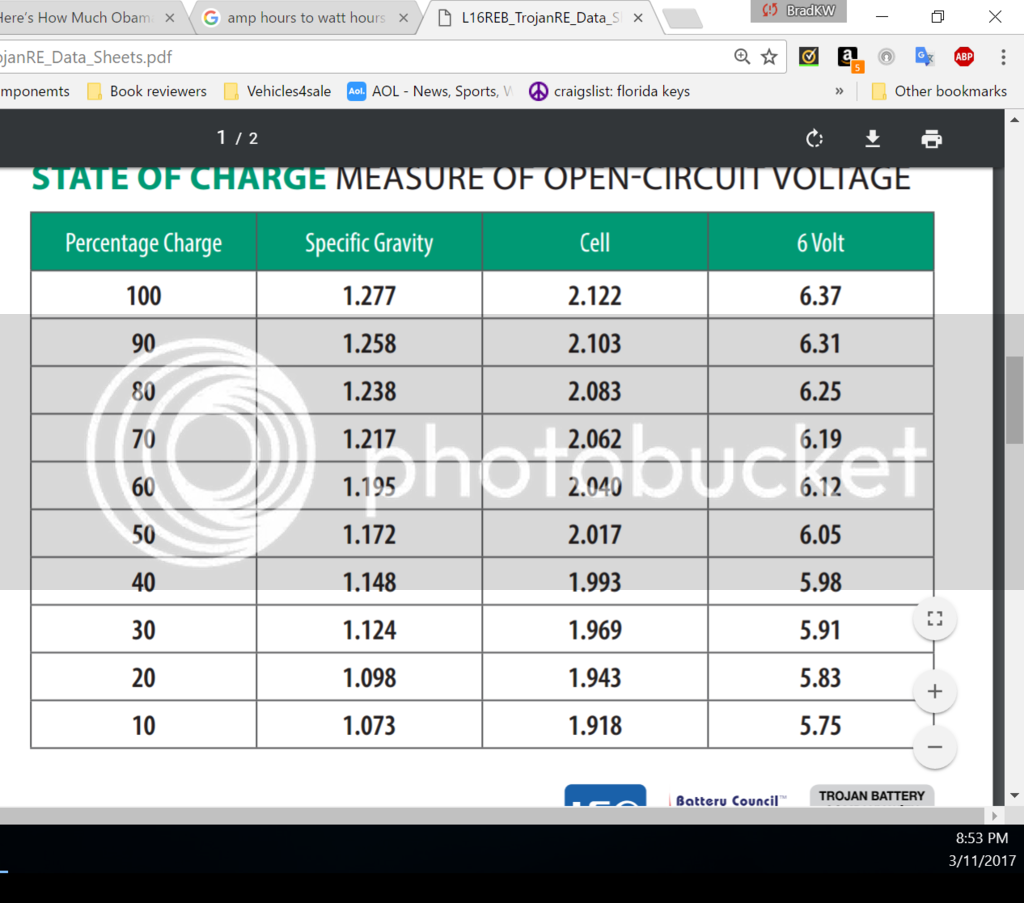For the first time today, I ran my AC unit off battery only for an extended period of 3 hours, where compressor ran 100% of time (no cycling) and from battery only (disconnected solar input).
I have 4 Trojan L16 batteries (6 volt) wired in series for a 24v bank. The most common measurement of a deep cycle battery's capacity is Amp Hours (Ah), and we use the 20 hour discharge column when talking about Ah. For example, a 200 Ah battery gets that rating from a tested 20 hour discharge cycle...the number changes if the discharge cycle is less or more time, but that's not really important for discussion purposes.
But Amp hours are really not an accurate measure of capacity for anything other than a 12v battery or battery bank...it's more a descriptive artifact that just happens to work for the most commonly used voltage, 12v. A more accurate measure is Watt Hours... that same 12v 200 Ah battery is really 2400 Watt Hours (Wh). This becomes more useful when talking about non-12v systems, such as my 24v battery bank. Having grown used to talking about Ah, I'm not 100% confident with my math having to convert to Watt hours.
A single 6v L16 battery is rated at 370 Ah. Four together is 24v and still 370 Ah. That should equate to a battery bank of 8,880 Watt hours (370 x 24). Divide by 2 to find what is usable without dropping below 50% SOC (state of charge) and we get 4,440 Watt hours usable. So if my AC draws 430 watts (which it does on high), then in theory I should get nearly 10.5 hours of operation before hitting 50% SOC. That doesn't take into account inverter inefficiencies or Peukert effect.
So this is what I got from my 3 hour test today:
Starting Specific Gravity (SG) after 5 days rest, no charging: 1.280 ...which is 100% full/charged. Voltage reads 25.6v, also indicating 100% charged.
Ran air conditioner with doors open so it had no chance to cycle off, and wattage varied between 390 and 430 according to KillaWatt meter. dunno why the variation, but after first hour it stayed pegged closer to 430 Watts. After 3 hours, I shut the system down and took readings after 15 min:
SG: 1.260 and 25.2 volts. Both readings would indicate an SOC of 90% remaining capacity. So -10% for 3 hours operation. So 9 hours operation = -30% ? Dunno yet.
Also had a couple cells read at 1.255 best I can tell...not sure why variation.
Overall though, I think that the results are promising and feel encouraged.

I have 4 Trojan L16 batteries (6 volt) wired in series for a 24v bank. The most common measurement of a deep cycle battery's capacity is Amp Hours (Ah), and we use the 20 hour discharge column when talking about Ah. For example, a 200 Ah battery gets that rating from a tested 20 hour discharge cycle...the number changes if the discharge cycle is less or more time, but that's not really important for discussion purposes.
But Amp hours are really not an accurate measure of capacity for anything other than a 12v battery or battery bank...it's more a descriptive artifact that just happens to work for the most commonly used voltage, 12v. A more accurate measure is Watt Hours... that same 12v 200 Ah battery is really 2400 Watt Hours (Wh). This becomes more useful when talking about non-12v systems, such as my 24v battery bank. Having grown used to talking about Ah, I'm not 100% confident with my math having to convert to Watt hours.
A single 6v L16 battery is rated at 370 Ah. Four together is 24v and still 370 Ah. That should equate to a battery bank of 8,880 Watt hours (370 x 24). Divide by 2 to find what is usable without dropping below 50% SOC (state of charge) and we get 4,440 Watt hours usable. So if my AC draws 430 watts (which it does on high), then in theory I should get nearly 10.5 hours of operation before hitting 50% SOC. That doesn't take into account inverter inefficiencies or Peukert effect.
So this is what I got from my 3 hour test today:
Starting Specific Gravity (SG) after 5 days rest, no charging: 1.280 ...which is 100% full/charged. Voltage reads 25.6v, also indicating 100% charged.
Ran air conditioner with doors open so it had no chance to cycle off, and wattage varied between 390 and 430 according to KillaWatt meter. dunno why the variation, but after first hour it stayed pegged closer to 430 Watts. After 3 hours, I shut the system down and took readings after 15 min:
SG: 1.260 and 25.2 volts. Both readings would indicate an SOC of 90% remaining capacity. So -10% for 3 hours operation. So 9 hours operation = -30% ? Dunno yet.
Also had a couple cells read at 1.255 best I can tell...not sure why variation.
Overall though, I think that the results are promising and feel encouraged.










































































